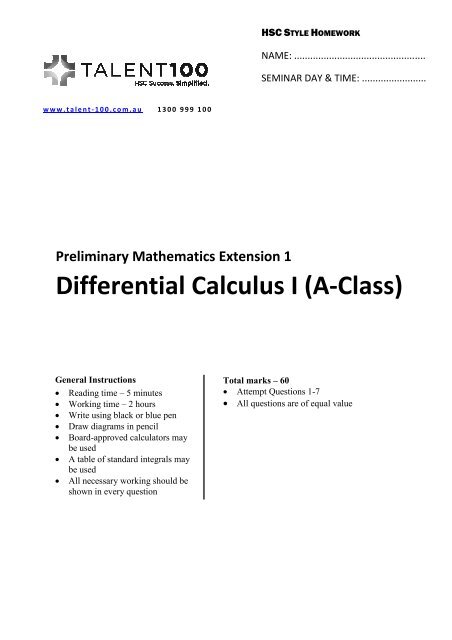Differential Calculus I (A-Class)
Differential Calculus I (A-Class) - Talent 100
Differential Calculus I (A-Class) - Talent 100
- No tags were found...
Create successful ePaper yourself
Turn your PDF publications into a flip-book with our unique Google optimized e-Paper software.
HSC STYLE HOMEWORK<br />
NAME: .................................................<br />
SEMINAR DAY & TIME: ........................<br />
w w w . t a l e n t - 1 0 0 . c o m . a u 1 3 0 0 9 9 9 1 0 0<br />
Preliminary Mathematics Extension 1<br />
<strong>Differential</strong> <strong>Calculus</strong> I (A-<strong>Class</strong>)<br />
General Instructions<br />
• Reading time – 5 minutes<br />
• Working time – 2 hours<br />
• Write using black or blue pen<br />
• Draw diagrams in pencil<br />
• Board-approved calculators may<br />
be used<br />
• A table of standard integrals may<br />
be used<br />
• All necessary working should be<br />
shown in every question<br />
Total marks – 60<br />
• Attempt Questions 1-7<br />
• All questions are of equal value
PMX Homework <strong>Differential</strong> <strong>Calculus</strong> I © TALENT 100<br />
Total marks – 60<br />
Attempt Questions 1–5<br />
All questions are of equal value<br />
Question 1 (12 marks)<br />
Marks<br />
The Second Derivative<br />
is the second derivative of , i.e. we differentiate twice<br />
(a)<br />
For each of the following functions, find <br />
.<br />
(i) = + 3 + 2 + 1 2<br />
(ii) = + 2 4 − 3 3<br />
(iii)<br />
= <br />
<br />
3<br />
TALENT 100: HSC SUCCESS. SIMPLIFIED.<br />
www.talent-100.com.au<br />
Page 2 of 14
PMX Homework <strong>Differential</strong> <strong>Calculus</strong> I © TALENT 100<br />
Concavity<br />
(b) Concavity is a measure of the curvature of the slope, i.e whether it is curving upwards or curving<br />
downwards.<br />
When a curve is concave down, < 0<br />
When a curve is concave up, > 0<br />
(b) Determine the concavity of the following curves at the point where = 5.<br />
(i) = + 2 − 5 + 3 − 1 2<br />
(ii) = 3 − 5 2<br />
End of Question 1<br />
TALENT 100: HSC SUCCESS. SIMPLIFIED.<br />
www.talent-100.com.au<br />
Page 3 of 14
PMX Homework <strong>Differential</strong> <strong>Calculus</strong> I © TALENT 100<br />
Marks<br />
Question 2 (12 marks)<br />
Stationary Points<br />
The second derivative will be positive for a min, i.e. > 0 for a max<br />
The second derivative will be negative for a max, i.e. < 0 for a max<br />
If = 0, the result is inconclusive and points will need to be tested<br />
Points of Inflexion<br />
STEP 1: Find the values of for which = 0<br />
STEP 2: Use a table of values to determine to determine the sign of around its zeroes. The<br />
second derivative must change sign for a point of inflexion.<br />
(a) For a particular function, it is known that = − √ − 2.<br />
(i) Suppose a stationary point exists at = 6. Determine the nature of 2<br />
the stationary point.<br />
TALENT 100: HSC SUCCESS. SIMPLIFIED.<br />
www.talent-100.com.au<br />
Page 4 of 14
PMX Homework <strong>Differential</strong> <strong>Calculus</strong> I © TALENT 100<br />
(ii) Find the values of for which has a point of inflexion. 2<br />
(iii) Find the values of for which is concave down. 2<br />
A Horizontal Point of Inflexion is a point around which the sign of does not change, but the<br />
sign of does change<br />
The tangent crosses the curve<br />
At a Horizontal Point of Inflexion, = 0 and = 0<br />
NOTE: = = 0 is not enough to prove a horizontal point of inflexion. Always<br />
remember to test points<br />
TALENT 100: HSC SUCCESS. SIMPLIFIED.<br />
www.talent-100.com.au<br />
Page 5 of 14
PMX Homework <strong>Differential</strong> <strong>Calculus</strong> I © TALENT 100<br />
(b) Consider the function = − − 8 + 32 + 1.<br />
(i) Find the coordinates of any stationary points and determine their nature. 3<br />
(ii) Find the coordinates of any points of inflexion. 2<br />
(iii) Briefly sketch the graph of = . 1<br />
End of Question 2<br />
TALENT 100: HSC SUCCESS. SIMPLIFIED.<br />
www.talent-100.com.au<br />
Page 6 of 14
PMX Homework <strong>Differential</strong> <strong>Calculus</strong> I © TALENT 100<br />
Question 3 (12 marks)<br />
Marks<br />
(a) Consider the function = <br />
√ .<br />
(i) State the domain of . 1<br />
(ii) Show that is concave down for all in its domain. 3<br />
(iii) Hence, find the coordinates of any stationary points of and 2<br />
determine their nature.<br />
TALENT 100: HSC SUCCESS. SIMPLIFIED.<br />
www.talent-100.com.au<br />
Page 7 of 14
PMX Homework <strong>Differential</strong> <strong>Calculus</strong> I © TALENT 100<br />
(iv) Neatly sketch the graph of = , showing all important features. 2<br />
(b) (i) Show that 0 = 0 = 0 given that = . 2<br />
(ii) Hence or otherwise, determine the nature of the stationary point at = 0. 2<br />
TALENT 100: HSC SUCCESS. SIMPLIFIED.<br />
End of Question 3<br />
www.talent-100.com.au<br />
Page 8 of 14
PMX Homework <strong>Differential</strong> <strong>Calculus</strong> I © TALENT 100<br />
Question 4 (12 marks)<br />
Marks<br />
(a)<br />
The diagram below shows the graph of = .<br />
−2,3<br />
<br />
0,1<br />
−4,0<br />
<br />
(i) On separate axis, sketch the graphs of = and = . 3<br />
TALENT 100: HSC SUCCESS. SIMPLIFIED.<br />
www.talent-100.com.au<br />
Page 9 of 14
PMX Homework <strong>Differential</strong> <strong>Calculus</strong> I © TALENT 100<br />
(ii) On separate axis, sketch possible graphs of = and = given 4<br />
that = , and that has a stationary point at 0,0.<br />
TALENT 100: HSC SUCCESS. SIMPLIFIED.<br />
www.talent-100.com.au<br />
Page 10 of 14
PMX Homework <strong>Differential</strong> <strong>Calculus</strong> I © TALENT 100<br />
(b)<br />
A particular function = + + + , has a horizontal point of inflexion<br />
at the point (1,3), where , and are constants.<br />
(i) Find expression for and . 2<br />
(ii) Find the values of , and . 3<br />
End of Question 4<br />
TALENT 100: HSC SUCCESS. SIMPLIFIED.<br />
www.talent-100.com.au<br />
Page 11 of 14
PMX Homework <strong>Differential</strong> <strong>Calculus</strong> I © TALENT 100<br />
Question 5 (12 marks)<br />
Marks<br />
(a) A particular function is defined by = <br />
.<br />
(i) State the domain of . 1<br />
(ii) Find the coordinates of any turning points, and determine their nature. 4<br />
TALENT 100: HSC SUCCESS. SIMPLIFIED.<br />
www.talent-100.com.au<br />
Page 12 of 14
PMX Homework <strong>Differential</strong> <strong>Calculus</strong> I © TALENT 100<br />
(iii) Find the coordinates of any points of inflexion 2<br />
(iv) Explain why − ≤ ≤ . 2<br />
TALENT 100: HSC SUCCESS. SIMPLIFIED.<br />
www.talent-100.com.au<br />
Page 13 of 14
PMX Homework <strong>Differential</strong> <strong>Calculus</strong> I © TALENT 100<br />
(v) Hence, neatly sketch the graph of = , clearly showing all turning 3<br />
points, points of inflexion and intercepts with the coordinate axis.<br />
End of paper<br />
TALENT 100: HSC SUCCESS. SIMPLIFIED.<br />
www.talent-100.com.au<br />
Page 14 of 14





